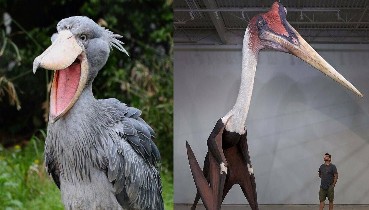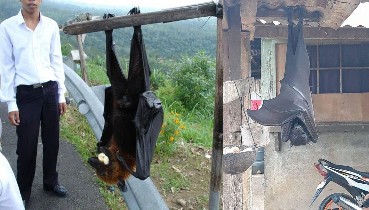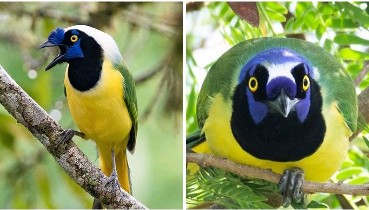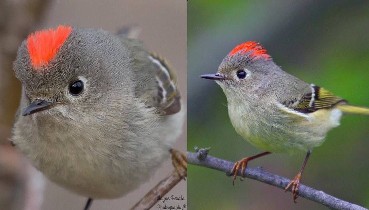In nature, there are many ways to protect yourself from potential predators: armor, poison, noxious smell, size or speed, etc. But perhaps no form of protection is as cunning as a disguise. Insects, whose body form has allowed for an impressive array of biological mimicry and deception, make particularly good use of camouflage. Some of these bugs might be indistinguishable from their surroundings, like the walking stick insect. Can you pick them out?
Dead Leaf Mantis
Adrian Pingstone / Wikimedia Commons / Public Domain
This praying mantis from Malaysia looks as if it were covered in dead leaves; in fact, some of those "leaves" are parts of its own body.1 The incredibly convincing camouflage helps them hide from predators, but it also allows them to be predators, too. A prey animal lurking in the leaf litter wouldn't know what hit it if it ran into one of these elusive hunters.
Dead Leaf Butterfly
Hsu Hong Lin / Flickr / CC BY 2.0
The underside of this butterfly's wings is truly a remarkable work of evolutionary art; they look just like a dead leaf, with the right shape, faded browns, blemish spots, veins and midrib, even jagged edges.2 Meanwhile, the upper side of the insect's wings displays bright colors more typical of butterflies. If they're looking for mates, they'll flash their colors, but if the butterfly wants to hide from predators, they simply close their wings.
Leaf Katydid
hagit berkovich / Shutterstock
The camouflage of this leaf katydid is so accurate that it even mimics a leaf's blemishes. Katydids are also often called "bush crickets," but unlike their cricket and grasshopper cousins, both males and females rub their wings together to sing to each other. They hear with ears on their front legs.
Walking Stick
Gilles San Martin / Flickr / CC BY-SA 2.0
The stick insects of the order Phasmatodea are genuinely some of the most bizarre critters on the planet. They are found on every continent except Antarctica. Their body has become so elongated that they appear like sticks, twigs, or thin branches. When resting still on a pile of twigs or at the end of a tree branch, stick insects are almost impossible to spot.
Orchid Mantis
Vince Adam / Shutterstock
These flowery predators from southeast Asian rainforests might look like the flamboyant sort, but they're actually ruthless killers. They use their camouflage, which mimics a flower petal, to attract and hide from their prey. When flies and other pollinators approach the flower with dreams of sweet nectar, the orchid mantis strikes.
Sand Grasshopper
Don DeBold / Flickr / CC BY 2.0
Calling these guys "grasshoppers" might seem like a misnomer due to their sandy habitat (and perfectly-matching camouflage), but they often use their camouflage to safely "hop" between brownish grasses adapted to sandy soils. Found in North America, they like sandy habitats with sparse grasses, such as the Western prairie.
Walking Leaf
Nandini Velho / Wikimedia Commons / CC BY-SA 3.0
Walking leaf insects are related to the walking sticks, but are in their own family (Phylliidae). As their name suggests, they have evolved to mimic leaves rather than sticks, though their long bodies allow them to take the form of a whole leafed branch—so their camouflage is particularly advanced. They can even sway back and forth like a twig to blend in further.
Peppered Moth
Henrik Larsson / Shutterstock
These remarkably adaptable bugs are often used as a textbook example of natural selection in action.3
Originally they evolved their "peppered" design to blend in perfectly when resting on light-colored trees and lichens. But due to excess pollution during the Industrial Revolution in England, many lichens died out and trees became blackened with soot. This made it easier for predators to find the moths, so the population began to evolve a darker, sooty coloration.
Today, the lighter-colored moths are again commonplace, as environmental standards have improved.
Assassin Bug
Orionmystery / Wikimedia Commons / CC BY-SA 3.0
This insect has taken a different, far creepier strategy for camouflage. Acanthaspis petax, a type of assassin bug, stacks the corpses of its victims on its back to hide from predators. Though it may seem like an odd strategy, studies have shown that corpse-carrying assassin bugs are 10 times less likely to be attacked by spiders.4
Thorn Bug
Ed Reschke / Getty Images
These deceptive insects, which are related to cicadas and leafhoppers, have developed enlarged and ornate pronotums, which resemble thorns on a branch. Looking like a part of the plant that they're resting on discourages predators from taking a bite for fear of injury. They're considered an occasional pest of ornamental and fruit trees in Central and South America, as well as parts of the southern United States.
Planthopper
Doug Lemke / Shutterstock
These grasshopper-like insects, distinguished by excellent camouflage, hide among the leaves upon which they feed. Despite their names, however, planthoppers only hop when they have to, preferring to move slowly so as not to attract attention, making them even more difficult to spot.5 They can move forward, backward, and shuffle sideways like a crab. As nymphs, planthoppers put on a flashy show to stay safe instead of relying on camouflage.


:max_bytes(150000):strip_icc():format(webp)/__opt__aboutcom__coeus__resources__content_migration__mnn__images__2014__07__DeadLeafMantisAmongLeavesInBristolZoo-928380dce75e4d2993ac43825eaa982d.jpg)
:max_bytes(150000):strip_icc():format(webp)/__opt__aboutcom__coeus__resources__content_migration__mnn__images__2018__09__DeadLeafButterflyHangingFromTreeBranch-8ea52666202e459897eb828d7595f672.jpg)
:max_bytes(150000):strip_icc():format(webp)/__opt__aboutcom__coeus__resources__content_migration__mnn__images__2014__07__LeafKatydidMatchesTheBlemishesOfTheLeafItSitsOn-2d6445f6d24349a78ca446a9b260d358.jpg)
:max_bytes(150000):strip_icc():format(webp)/__opt__aboutcom__coeus__resources__content_migration__mnn__images__2018__09__PhasmatodeaWalkingStickInsectOnLeaf-eaf50b8dc8f14ea198b004cc40b27d5a.jpg)
:max_bytes(150000):strip_icc():format(webp)/__opt__aboutcom__coeus__resources__content_migration__mnn__images__2018__09__OrchidMantisBlendsIntoSurroundingsWithItsPetalRear-10aae2dd88eb4f26b33e14874c96ddad.jpg)
:max_bytes(150000):strip_icc():format(webp)/__opt__aboutcom__coeus__resources__content_migration__mnn__images__2014__07__SandGrasshopperInPebblySandSurface-66c7fb92eb124255bdf2dce5cbce7a1b.jpg)
:max_bytes(150000):strip_icc():format(webp)/__opt__aboutcom__coeus__resources__content_migration__mnn__images__2014__07__WalkingLeafInsectInNaturePreserve-b77fac1b83f34087bc5c5fb97e1f46e9.jpg)
:max_bytes(150000):strip_icc():format(webp)/__opt__aboutcom__coeus__resources__content_migration__mnn__images__2014__07__PepperedMothAgainstTreeBark-885dbd5e3f5c4c229625dce1c851a0ba.jpg)
:max_bytes(150000):strip_icc():format(webp)/__opt__aboutcom__coeus__resources__content_migration__mnn__images__2014__07__AssassinBugAcanthaspisPetaxWithDeadAntsOnIt-74a15c4dd298408691f6329e6438f573.jpg)
:max_bytes(150000):strip_icc():format(webp)/thorn-bugs-mimicking-thorny-twigs-157121807-bfbcdc1008f04432ae8bb7367ebe399e.jpg)
:max_bytes(150000):strip_icc():format(webp)/__opt__aboutcom__coeus__resources__content_migration__mnn__images__2014__07__GreenPlantleafHopperInsectOnStem-c3b63b13652f43b68469c896350e34f7.jpg)











